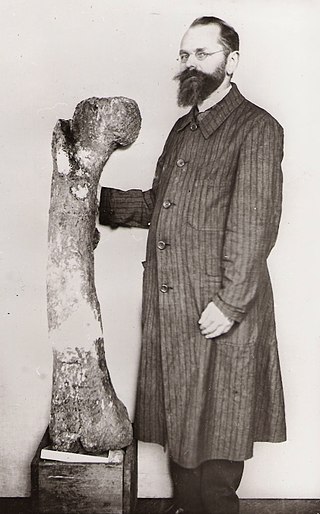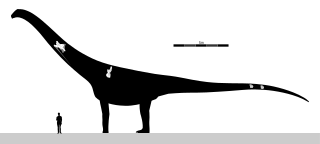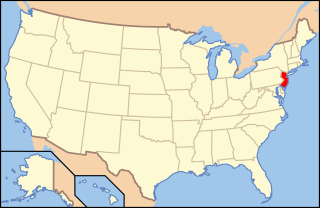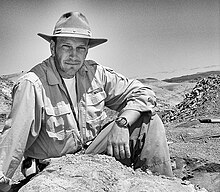
Ernst Freiherr Stromer von Reichenbach was a German paleontologist best remembered for his expedition to Egypt, during which the discovery of the first known remains of Spinosaurus was made.
Jeffrey A. Wilson, also known as JAW, is a paleontologist and professor of geological sciences and assistant curator at the Museum of Paleontology at the University of Michigan.

Rinconsaurus is a genus of titanosaur sauropod dinosaur from the Late Cretaceous in what is now Argentina. The type species, Rinconsaurus caudamirus, was described by Calvo and Riga in 2003, and is based on three partial skeletons.

Puertasaurus is a genus of sauropod dinosaur that lived in South America during the Late Cretaceous Period. It is known from a single specimen recovered from sedimentary rocks of the Cerro Fortaleza Formation in southwestern Patagonia, Argentina, which probably is Campanian or Maastrichtian in age. The only species is Puertasaurus reuili. Described by the paleontologist Fernando Novas and colleagues in 2005, it was named in honor of Pablo Puerta and Santiago Reuil, who discovered and prepared the specimen. It consists of four well-preserved vertebrae, including one cervical, one dorsal, and two caudal vertebrae. Puertasaurus is a member of Titanosauria, the dominant group of sauropods during the Cretaceous.
The Xiagou Formation is the middle strata of the Xinminbao Group. It is named for its type site in Xiagou, in the Changma Basin of Gansu Province, northwestern China and is considered Early Cretaceous in age. It is known outside the specialized world of Chinese geology as the site of a Lagerstätte in which the fossils were preserved of Gansus yumenensis, the earliest true modern bird.
Matthew Carl Lamanna is a paleontologist and the assistant curator of vertebrate paleontology at the Carnegie Museum of Natural History, where he oversees the dinosaur collection.

Orkoraptor is a genus of medium-sized megaraptoran theropod dinosaur from the late Cretaceous Period of Argentina. It is known from incomplete fossil remains including parts of the skull, teeth, tail vertebrae, and a partial tibia. The specialized teeth resemble those of some maniraptoriform theropods, namely the deinonychosaurs and compsognathids. This and other anatomical features led the authors who described it to suggest that it was a maniraptoran coelurosaur. However, subsequent studies found it to be a megaraptoran. Found in the Cerro Fortaleza Formation of Southern Patagonia, it is one of the southernmost carnivorous dinosaurs known from South America.
David W. Krause is a Canadian-born vertebrate paleontologist currently working as Senior Curator of Vertebrate Paleontology at the Denver Museum of Nature and Science, which he joined in 2016. Prior to that he was a Distinguished Service Professor in the Department of Anatomical Sciences at Stony Brook University, where he was employed for 34 years. His work primarily focuses on fossils from the Cretaceous period of Madagascar, and he often travels to the island to uncover new fossils. He is most famous for his discoveries of Majungasaurus crenatissimus and Beezlebufo ampinga. Rapetosaurus krausei, another dinosaur from Madagascar, is named in his honor. Krause is also the founder of the Madagascar Ankizy Fund, which is dedicated to educating and providing healthcare for poor children in Madagascar.
Stromerosuchus is a dubious genus of Late Cretaceous crocodyliform. Fragmentary remains have been found from the Cenomanian-age Bahariya Formation of Egypt. The genus was named in 1936 by Oskar Kuhn. It is named in honor of Ernst Stromer, the German paleontologist who found the fossils in the Bahariya Oasis in 1911 and described them in 1922. After their discovery, the fossils, along with many others found from Bahariya, were in the possession of the Egyptian Geological Survey. In 1922, the fossils were sent back to Stromer, but they were badly crushed in shipment from Egypt. Because the known remains are so poor, the genus is now regarded as a nomen dubium. Some material has been referred to the genera Aegyptosuchus and Stomatosuchus, both named by Stromer from the Bahariya material.
The Nalut Dinosaur Museum is a paleontological museum located in Nalut, Libya. The fossils, which date from the Cretaceous period, were discovered by a joint expedition of Libyan geologists and American paleontologists. The collection is housed in a wing of the Red Crescent building in Nalut.

Paralititan was a giant titanosaurian sauropod dinosaur genus discovered in coastal deposits in the Upper Cretaceous Bahariya Formation of Egypt. It lived between 99.6 and 93.5 million years ago.

Paleontology in New Jersey refers to paleontological research in the U.S. state of New Jersey. The state is especially rich in marine deposits.

Katepensaurus is an extinct genus of rebbachisaurid sauropod dinosaur known from the Late Cretaceous of south-central Chubut Province of central Patagonia, Argentina. It contains a single species, Katepensaurus goicoecheai.

Anzu is a monospecific genus of caenagnathid dinosaur from North Dakota, South Dakota and Montana that lived during the Late Cretaceous in what is now the Hell Creek Formation. The type species and only species, Anzu wyliei is known from numerous skeletons that preserve cranial and postcranial elements. It was named in 2014 by Matthew C. Lamanna, Hans-Dieter Sues, Emma R. Schachner, and Tyler R. Lyson.

Dreadnoughtus is a genus of titanosaurian sauropod dinosaur containing a single species, Dreadnoughtus schrani. D. schrani is known from two partial skeletons discovered in Upper Cretaceous rocks of the Cerro Fortaleza Formation in Santa Cruz Province, Argentina. It is one of the largest terrestrial vertebrates known, with the immature type specimen measuring 26 metres (85 ft) in total body length and weighing 48–49 metric tons. D. schrani is known from more complete skeletons than any other gigantic titanosaurian.

Notocolossus is a genus of titanosaurian sauropod dinosaur from late Cretaceous strata of Mendoza Province, Argentina.

Bernardo Javier González Riga is an Argentine palaeontologist; he is internationally recognised for his research on sauropod dinosaur evolution, and was awarded in 2019. He discovered in the Late Cretaceous strata of the Mendoza Province (Argentina) the huge sauropod dinosaur Notocolossus, one of the largest land animals ever found. He also described and co-described more than ten new dinosaur species.

Jingmai Kathleen O'Connor is a paleontologist who works as a curator at the Field Museum.

Abditosaurus is an extinct genus of titanosaurian sauropod dinosaur from the Late Cretaceous (Maastrichtian) Tremp Group of Catalonia, Spain. The type and only species is Abditosaurus kuehnei. Phylogenetic analyses recover it within a clade of South American and African saltasaurines, distinct from other insular dwarf sauropods from the European archipelago. Abditosaurus inhabited the Ibero-Armorican Island, a prehistoric island made up of what is now Spain, Portugal, and southern France, and would have been the largest titanosaur species in its environment.

The Jean and Ric Edelman Fossil Park, located in Mantua Township, New Jersey, consists of a 66-million-year-old 6-inch (150 mm) bone bed set into a 65-acre (26 ha) former marl quarry. It is currently the only facility east of the Mississippi River that has an active open quarry for public Community Dig Days. Formed at the end of the Cretaceous Period during the Cretaceous-Paleogene extinction event, this rich fossil deposit is abundant in marine life which is indicative of the shallow sea that once covered the area that would become Southern New Jersey. The fossil park is undergoing renovations to become the site of the Jean and Ric Edelman Fossil Park Museum and will be available for school, scout, camp, and public programs once construction is complete. It is currently closed to the public and will reopen after the completion of the museum in 2023. The Jean and Ric Edelman Fossil Park is owned and operated by Rowan University in Glassboro, New Jersey thanks in part to a generous donation from Jean and Ric Edelman.














